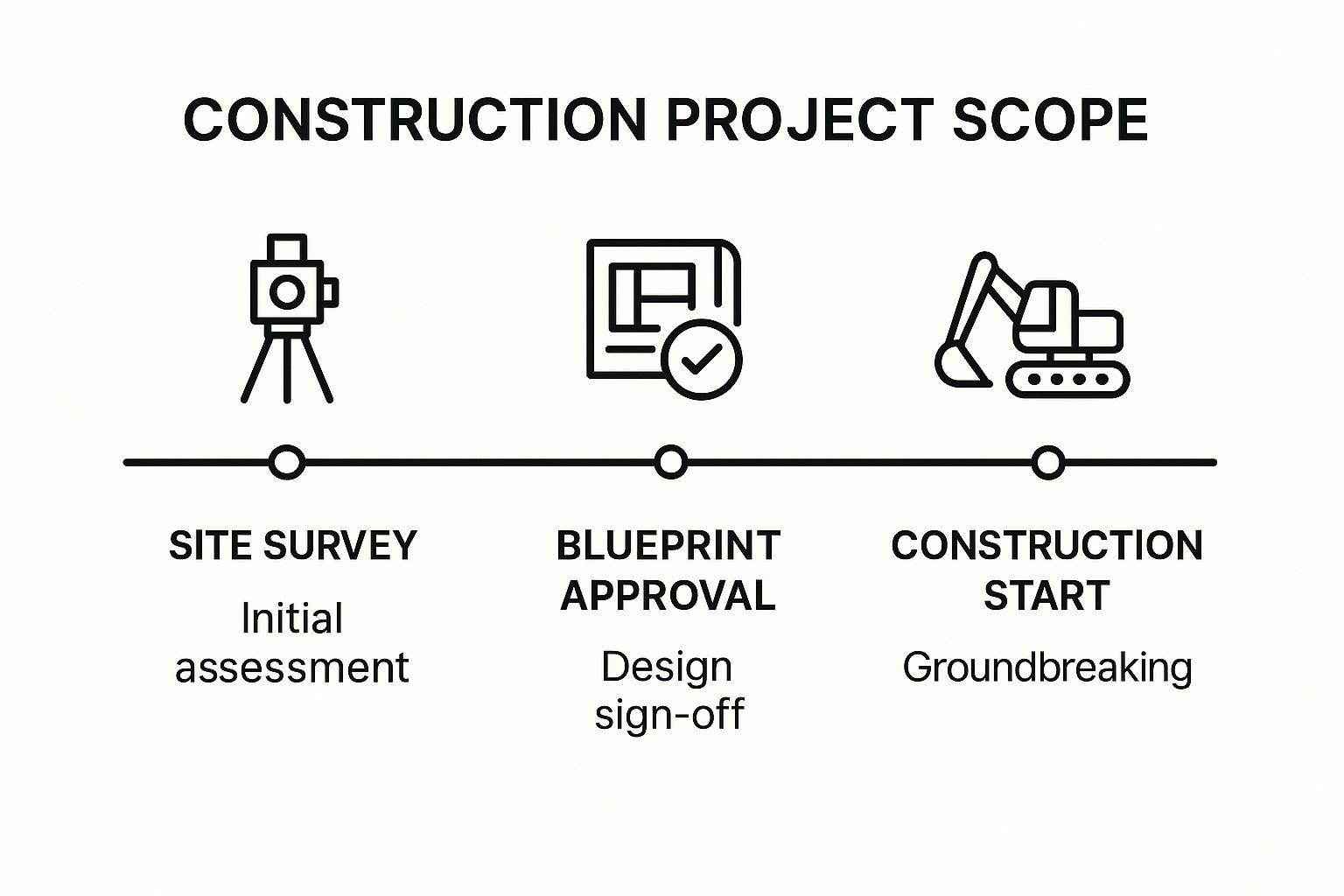Starting a creative project without a clearly defined scope is like setting sail without a map-you might end up somewhere interesting, but it is rarely where you intended to go. Scope creep, missed deadlines, and budget overruns are the common monsters lurking in these uncharted waters. A well-crafted project scope statement acts as your compass and charter, providing a single source of truth for clients, stakeholders, and your creative team.
It transforms abstract ideas into a concrete plan by meticulously outlining deliverables, boundaries, assumptions, and constraints. This foundational document is the difference between project chaos and project success. Understanding the pitfalls of a poorly defined scope is crucial, and one of the most common challenges that arises is managing project scope creep. A strong initial scope is your first line of defense against this pervasive issue.
In this article, we'll dissect several diverse project scope example scenarios, providing detailed analysis and actionable takeaways to help you master this critical skill. Whether you're in software development, marketing, or construction, learning to define project scope effectively will save you time, money, and countless headaches. We will break down exactly what makes each example work and how you can apply these principles to your own projects.
1. Software Development Project Scope
A Software Development Project Scope is a foundational document that outlines the entire lifecycle of creating a software application. It precisely defines all deliverables, features, functionalities, and constraints. This scope acts as the single source of truth for the development team, stakeholders, and project managers, ensuring everyone is aligned on the final product's vision and technical requirements.

This type of scope is essential because software projects are notoriously complex and prone to scope creep. By detailing everything from user stories and system architecture to testing parameters and deployment plans upfront, it mitigates risks, manages expectations, and provides a clear roadmap for execution. Without this clarity, projects can easily derail due to miscommunication, feature bloat, or undefined success metrics.
Example Breakdown: Spotify's Music Streaming App
A great project scope example in software is the development of a platform like Spotify. Their initial scope would have focused on core functionalities for a Minimum Viable Product (MVP).
- Project Goal: Launch a desktop music streaming application that provides users legal access to a vast library of music.
- Key Deliverables:
- A functional desktop application for Windows and macOS.
- User account creation and login system.
- Search functionality for artists, albums, and tracks.
- Basic playlist creation and management.
- A backend infrastructure capable of streaming audio with minimal latency.
- Out of Scope (for MVP): Mobile apps, offline downloads, podcast integration, social sharing features, and advanced recommendation algorithms. These were planned for future iterations.
- Assumptions: Licensing agreements with major record labels will be secured. Users will have a stable internet connection for streaming.
This phased approach allowed Spotify to launch, gather user feedback, and incrementally add features. Defining what was out of scope was just as critical as defining what was in, preventing the team from getting overwhelmed and ensuring a focused, timely launch. Effective scope management is a continuous process, and you can learn more about the best practices for controlling project scope here.
Strategic Takeaways
To apply this to your own software projects, focus on these actionable strategies:
- Embrace User Stories: Frame functional requirements from the user's perspective (e.g., "As a user, I want to create a playlist so I can organize my favorite songs"). This keeps the development process user-centric.
- Define Clear Acceptance Criteria: For each feature, specify the exact conditions that must be met for it to be considered complete. This eliminates ambiguity during the testing and review phases.
- Plan for Iteration: Rarely is a software project's scope static. Build in processes for scope refinement based on an iterative, agile approach. This allows for flexibility while maintaining control.
2. Construction Project Scope
A Construction Project Scope is a comprehensive document that serves as the architectural and operational blueprint for a building project. It meticulously details every aspect of the work required, from the initial site survey to the final handover. The scope defines all deliverables, materials, labor, equipment, timelines, and quality standards, ensuring compliance with architectural plans, engineering specifications, and local building codes.
This type of scope is critical for managing the immense complexity and high stakes of construction. It acts as the master guide for contractors, architects, engineers, and clients, creating a shared understanding of the project's objectives and constraints. By clearly outlining every task and requirement, it helps prevent costly disputes, schedule overruns, and quality issues that can plague construction ventures.
The visualization below outlines the foundational milestones in a typical construction project's lifecycle, from initial assessment to groundbreaking.

These sequential steps illustrate the importance of locking down critical decisions and approvals before committing to the high costs of physical construction.
Example Breakdown: One World Trade Center
A powerful project scope example from the construction world is the rebuilding of One World Trade Center in New York City. Its scope was extraordinarily complex, balancing symbolic significance with cutting-edge engineering and security demands.
- Project Goal: Construct an iconic, 1,776-foot skyscraper that serves as a beacon of resilience while meeting the highest standards of safety, sustainability, and commercial viability.
- Key Deliverables:
- A 104-story commercial office tower with over 3 million square feet of space.
- A reinforced, blast-resistant concrete base and redundant safety systems.
- LEED Gold certification for environmental sustainability.
- Integration with a public observation deck, broadcast facilities, and underground transportation hub.
- Out of Scope (for this specific building): The design and construction of the surrounding memorial plaza, museum, or adjacent towers, which were managed as separate but interconnected projects.
- Assumptions: The site's complex underground infrastructure (subway lines, utilities) could be navigated and rebuilt. New security technologies would be successfully integrated.
This rigorous scope ensured that despite immense political, emotional, and technical pressures, the project team could deliver a structure that met its multifaceted goals. Defining the project's boundaries was crucial for coordinating the hundreds of contractors and stakeholders involved.
Strategic Takeaways
To apply these principles to your construction projects, consider these actionable strategies:
- Establish a Clear Change Order Process: Unforeseen issues are inevitable in construction. Define a formal process for how changes are proposed, reviewed, approved, and documented to control scope creep and budget impacts.
- Conduct Thorough Site Surveys: Before finalizing any plans, invest in a comprehensive analysis of the site's geological, environmental, and existing infrastructure conditions. This upfront diligence prevents major surprises during excavation and foundation work.
- Integrate Quality Control Checkpoints: Build regular inspections and quality assurance reviews into the project timeline at critical milestones. This ensures work meets specified standards and reduces the need for costly rework later on. This ties directly into managing suppliers and contractors effectively, and you can explore more on the subject by reviewing vendor management best practices.
3. Marketing Campaign Project Scope
A Marketing Campaign Project Scope is a strategic framework that defines all activities, channels, content, and metrics for executing a marketing initiative. It provides a clear blueprint covering target audience definition, messaging strategy, creative asset development, media planning, budget allocation, and the key performance indicators (KPIs) for success. This scope aligns marketing, sales, and creative teams around a unified set of goals and execution plans.
This type of scope is critical for preventing wasted ad spend and inconsistent brand messaging. Marketing campaigns involve many moving parts across various platforms, making them susceptible to disorganization and unclear objectives. A well-defined scope ensures every piece of content, every ad placement, and every dollar spent directly contributes to the overarching campaign goal, from building brand awareness to driving direct sales.
Example Breakdown: Apple's iPhone Launch Campaign
A masterful project scope example in marketing is any of Apple's iPhone launch campaigns. Their scope is meticulously planned to create global anticipation and drive record-breaking sales within a short window.
- Project Goal: Launch the new iPhone model, achieving specific pre-order and first-weekend sales targets while reinforcing Apple's brand image of innovation and premium quality.
- Key Deliverables:
- A suite of creative assets including a keynote presentation, product demonstration videos, high-resolution product photography, and digital ad banners.
- A coordinated global public relations and media outreach plan.
- Updated in-store retail experiences and training materials for staff.
- A multi-channel digital advertising campaign across social media, search, and video platforms.
- Out of Scope: Major software updates for older devices, detailed technical support documentation (handled by a separate team), or promotions for other product lines like MacBooks or iPads.
- Assumptions: Production and supply chain will meet launch demand. Major media outlets will cover the launch event. Retail partners will adhere to merchandising guidelines.
This focused approach allows Apple to create an immersive, consistent, and highly persuasive launch experience. By strictly defining the deliverables and excluding unrelated activities, they ensure maximum impact and market penetration for their flagship product.
Strategic Takeaways
To apply this level of precision to your own marketing campaigns, focus on these actionable strategies:
- Develop Detailed Personas: Go beyond basic demographics. Define your target audience's pain points, media consumption habits, and motivations to ensure your messaging resonates deeply.
- Establish Clear Approval Processes: For every creative asset, from a tweet to a video ad, define the stakeholder review and approval workflow. This prevents bottlenecks and ensures brand consistency.
- Integrate A/B Testing Parameters: Build testing directly into the scope. Specify which elements will be tested (e.g., headlines, images, calls-to-action) and what metrics will determine the winner. This turns campaign execution into a learning opportunity. You can discover more about the best ways for measuring marketing effectiveness here.
4. Event Planning Project Scope
An Event Planning Project Scope defines all the tasks, resources, and parameters required to execute a successful event. It functions as a master plan, covering everything from initial concept and venue selection to on-site logistics, post-event analysis, and budget constraints. This document is critical for aligning stakeholders, vendors, and the event team on a shared vision and set of objectives.

This type of scope is indispensable for managing the immense complexity and numerous moving parts of any event, whether it's a corporate conference, a music festival, or a non-profit fundraiser. It helps prevent common pitfalls like budget overruns, logistical failures, and a poor attendee experience by establishing clear boundaries and expectations from the outset. For a complete blueprint on managing all phases of an event, including its initial scope definition, explore a guide on how to plan an event.
Example Breakdown: Apple's Worldwide Developers Conference (WWDC)
A premier project scope example in event planning is Apple's annual WWDC. The scope for such a high-profile event must be incredibly detailed to ensure a flawless experience that aligns with the company's brand standards.
- Project Goal: To host a world-class conference for Apple's global developer community, unveiling new software and technologies while fostering engagement and education.
- Key Deliverables:
- A high-production keynote presentation streamed globally.
- Multiple developer sessions and hands-on labs with functional tech setups.
- Venue logistics management, including security, catering, and attendee flow.
- An online platform and mobile app for session scheduling and virtual attendance.
- Post-event feedback collection and analytics reporting.
- Out of Scope: Individual developer project support, hardware sales at the event, or third-party (non-Apple) technology showcases.
- Assumptions: Key executives and presenters will be available. The chosen venue can support the immense technical and security requirements. Global streaming infrastructure will perform without failure.
By meticulously scoping every detail, from the keynote's timing down to the accessibility ramps, Apple ensures WWDC is a seamless, impactful event year after year. The clearly defined scope allows hundreds of vendors and internal teams to work in concert toward a single, unified goal.
Strategic Takeaways
To apply these principles to your own events, focus on these actionable strategies:
- Develop a Run-of-Show Document: Create a minute-by-minute schedule for the entire event. This document is the ultimate tactical tool for keeping everyone synchronized, from stage managers to catering staff.
- Establish Clear Contingency Plans: What happens if a keynote speaker is delayed or the primary AV system fails? Scope out potential risks and define specific backup plans to mitigate disruptions and maintain professionalism.
- Define Vendor Communication Protocols: Clearly outline how, when, and with whom each vendor should communicate. This prevents miscommunication and ensures issues are resolved by the right person quickly. Learn more about effective strategies for nonprofit event planning here.
5. Research and Development Project Scope
A Research and Development (R&D) Project Scope provides a systematic framework for exploring new technologies, products, or processes. It meticulously defines the research objectives, experimental methodologies, specific success criteria, and potential pathways to commercialization. This scope serves as a critical guide for scientists, engineers, and stakeholders, ensuring that innovation efforts are focused, measurable, and aligned with strategic business goals.
This type of scope is vital because R&D projects are inherently uncertain and resource-intensive. By establishing clear parameters for literature reviews, experimental designs, data collection protocols, and intellectual property considerations, it imposes structure on the discovery process. A well-defined R&D scope prevents aimless exploration, manages investment risks, and creates clear go/no-go decision points based on empirical evidence.
Example Breakdown: Pfizer-BioNTech's COVID-19 Vaccine Development
A landmark project scope example in R&D is the accelerated development of the Pfizer-BioNTech COVID-19 vaccine. The scope was incredibly precise to manage the unprecedented speed and global urgency.
- Project Goal: To develop, test, and gain emergency regulatory approval for a safe and effective mRNA-based vaccine against the SARS-CoV-2 virus within a 12-18 month timeframe.
- Key Deliverables:
- A stable mRNA vaccine candidate (BNT162b2).
- Successful completion of Phase I, II, and III clinical trials with specific efficacy and safety endpoints.
- Submission of comprehensive data packages to regulatory agencies like the FDA and EMA.
- A scalable manufacturing process capable of producing billions of doses.
- A functional cold-chain logistics and distribution plan.
- Out of Scope (for Initial Approval): Long-term (5+ year) efficacy studies, development of a single-dose regimen, or a room-temperature stable formulation. These were objectives for subsequent research phases.
- Assumptions: mRNA technology would prove viable for a viral vaccine. Global regulatory bodies would accept an Emergency Use Authorization pathway. Manufacturing partners could be secured and scaled rapidly.
This rigorous scope, with its phased trial structure and clear deliverables, allowed the team to operate in parallel tracks, compressing years of work into months. Defining what was not an immediate goal was crucial for concentrating resources on the most critical path to a viable vaccine.
Strategic Takeaways
To apply this R&D approach to your own innovation projects, focus on these actionable strategies:
- Establish Go/No-Go Milestones: Define clear, data-driven decision points at the end of each research phase. For example, "Proceed to Phase II only if the compound shows a minimum of X% efficacy with no major adverse events in Phase I." This enforces discipline and prevents investment in failing projects.
- Prioritize Intellectual Property (IP) Protection: Integrate IP strategy from day one. Document every experiment, discovery, and protocol meticulously. This ensures that any valuable innovations are legally protected and can be commercialized.
- Plan for Iterative Failure: R&D is not linear. Build a scope that anticipates and learns from failed experiments. Frame hypotheses in a way that even a negative result provides valuable information to guide the next iteration, turning failures into productive learning opportunities.
6. IT Infrastructure Project Scope
An IT Infrastructure Project Scope is a highly technical document detailing the implementation, upgrade, or maintenance of an organization's core technology backbone. It defines the hardware, software, networks, and security measures involved. This scope serves as the blueprint for IT teams, system architects, and stakeholders, ensuring alignment on system performance, security protocols, and operational continuity.
This type of scope is critical for projects that form the digital foundation of a business. These initiatives are often complex, expensive, and carry significant operational risk. By clearly outlining everything from server specifications and network topology to disaster recovery plans and user access policies, an IT infrastructure scope minimizes service disruptions, prevents budget overruns, and ensures the final system meets business demands for reliability and scalability.
Example Breakdown: Amazon Web Services (AWS) Global Expansion
A prime project scope example in IT infrastructure is the continual expansion of Amazon's AWS cloud services into new global regions. Each new data center region represents a massive infrastructure project with a meticulously defined scope.
- Project Goal: To launch a new, fully operational AWS region in a specific geographic area, providing local businesses with low-latency access to cloud computing services while ensuring data sovereignty and high availability.
- Key Deliverables:
- Multiple physical data centers (Availability Zones) with independent power, cooling, and networking.
- Deployment of all core AWS services (e.g., EC2 for compute, S3 for storage) within the new region.
- A high-speed, redundant network backbone connecting all Availability Zones and linking them to the global AWS network.
- Robust physical and cybersecurity protocols compliant with local and international standards.
- Out of Scope (for initial launch): Deployment of niche or newly developed AWS services, which are typically rolled out to new regions in subsequent phases. Integration with third-party local cloud providers.
- Assumptions: Stable political and economic environment in the host country. Availability of reliable power grids and fiber optic networks. Access to a skilled local workforce for operations and maintenance.
This structured and phased approach allows AWS to replicate its infrastructure deployment model globally with precision and control. Defining what services are out of scope for the initial launch is crucial for managing complexity and meeting aggressive timelines for bringing a new region online.
Strategic Takeaways
To apply this to your own IT infrastructure projects, focus on these actionable strategies:
- Conduct a Thorough "As-Is" Assessment: Before planning the "to-be" state, you must comprehensively document the current infrastructure. This baseline analysis is essential for identifying dependencies, risks, and integration points.
- Plan for Scalability: Design the infrastructure not just for current needs but for future growth. Specify performance requirements and architecture that can scale without requiring a complete overhaul.
- Integrate Comprehensive Testing: The scope must include detailed plans for multiple testing phases: unit testing, integration testing, performance testing, and user acceptance testing (UAT). This validates system stability before go-live. You can explore how to structure this in a sample project scope document here.
Project Scope Comparison: 6 Key Examples
| Project Scope Type | Implementation Complexity 🔄 | Resource Requirements ⚡ | Expected Outcomes 📊 | Ideal Use Cases 💡 | Key Advantages ⭐ |
|---|---|---|---|---|---|
| Software Development | Medium to high; detailed documentation and updates | Skilled developers, testing tools, platforms | Clear technical roadmap, quality assurance, stakeholder alignment | Software apps, system development, Agile projects | Reduces scope creep, accurate estimations, QA facilitation |
| Construction | High; complex coordination with multiple stakeholders | Materials, labor, equipment, regulatory expertise | Complete, compliant buildings with controlled costs | Building projects, infrastructure development | Clear blueprints, cost control, regulatory compliance |
| Marketing Campaign | Medium; dynamic with adaptability needed | Creative teams, media buying, analytics tools | Consistent messaging, ROI tracking, brand impact | Product launches, brand awareness campaigns | Effective budget allocation, success metrics, team coordination |
| Event Planning | Medium; extensive vendor coordination and logistics | Venues, catering, AV tech, security personnel | Smooth event execution, attendee satisfaction | Conferences, festivals, ceremonies | Risk reduction, timeline clarity, memorable experiences |
| Research and Development | High; uncertainty and long timelines | Specialized equipment, expert personnel | Innovation, IP creation, market-ready products | New tech development, pharmaceuticals, scientific exploration | Systematic investigation, collaboration, IP protection |
| IT Infrastructure | High; technical complexity and ongoing maintenance | Hardware, software, network, security resources | Scalable, secure IT systems with minimal downtime | IT system upgrades, cloud infrastructure, network setup | Scalability, security framework, smooth transitions |
From Blueprint to Brilliance: Making Your Scope Work for You
Throughout this guide, we've journeyed through diverse project scope examples, from intricate software development to dynamic marketing campaigns. The core lesson is clear: a well-defined project scope is not a barrier to creativity. It is the very foundation upon which successful, innovative work is built. It acts as your project's constitution, a shared source of truth that aligns stakeholders, protects teams from burnout, and transforms ambitious ideas into tangible, measurable outcomes.
Seeing a detailed project scope example laid out reveals its true power. It preemptively answers the tough questions, defines the boundaries of the sandbox you get to play in, and ensures that every ounce of creative energy is channeled productively toward a shared goal. Without this clarity, projects often fall victim to the dreaded scope creep, where small, un-scoped additions slowly derail timelines and bloat budgets, leading to frustration for clients and creators alike.
Key Takeaways for Crafting a Powerful Scope
As you move forward to draft your next project scope, remember these critical takeaways:
- Specificity is Your Superpower: Vague terms like "user-friendly design" or "engaging content" are useless. Quantify everything possible. Define what "complete" looks like for each deliverable, specify the number of revision rounds, and clearly list what is out of scope.
- Assumptions are Risks in Disguise: Every unstated assumption is a potential point of conflict. Your scope statement must explicitly document all key assumptions, from resource availability and stakeholder response times to technical dependencies. This converts potential misunderstandings into agreed-upon parameters.
- Tie Everything to a "Why": A great scope doesn't just list what you're doing; it connects it back to the project objectives. Explaining how each deliverable contributes to the overarching business goal creates buy-in and makes it easier to evaluate change requests later.
Your Actionable Next Steps
Mastering the art of the project scope is an ongoing practice, not a one-time lesson. Ultimately, a well-defined scope is a cornerstone of overall project success. To further enhance your project execution, consider adopting broader project management best practices. By integrating solid scope management into a wider framework of proven strategies, you create a resilient structure capable of handling complexity and delivering consistent results.
The examples we've analyzed demonstrate that a robust scope is your single most effective tool for risk mitigation and quality assurance. It empowers you to say "no" to distracting requests while confidently saying "yes" to the work that truly matters. This document is your blueprint for brilliance, enabling you to build with precision, clarity, and creative freedom.
Ready to partner with creative professionals who understand the importance of a well-defined plan? Creativize connects you with a curated network of elite freelancers and agencies who excel at turning clear scopes into exceptional results. Find the perfect talent to bring your vision to life at Creativize.

